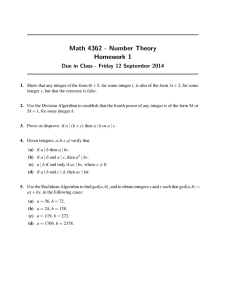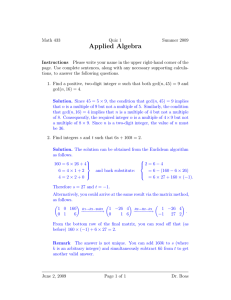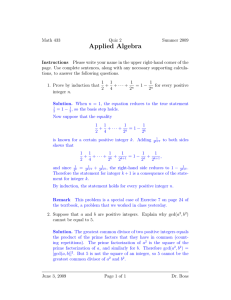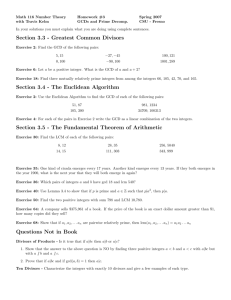MATH 433 Applied Algebra Lecture 1: Division of integers.
advertisement
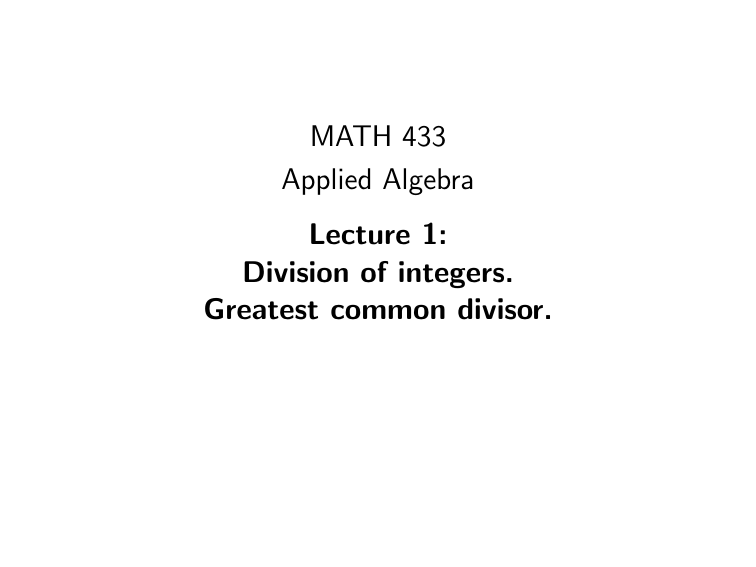
MATH 433
Applied Algebra
Lecture 1:
Division of integers.
Greatest common divisor.
Integer numbers
Positive integers: P = {1, 2, 3, . . . }
Natural numbers: N = {0, 1, 2, 3, . . . }
Integers: Z = {. . . , −2, −1, 0, 1, 2, . . . }
Arithmetic operations: addition, subtraction,
multiplication, and division.
Addition and multiplication are well defined for the
natural numbers N. Subtraction is well defined for
the integers Z (only partially defined on N).
Division by a nonzero number is well defined on the
set of rational numbers Q (only partially defined on
Z and N).
Division of integer numbers
Let a and b be integers and a 6= 0. We say that
a divides b or that b is divisible by a if b = aq
for some integer q. The integer q is called the
quotient of b by a.
Notation: a | b (a divides b)
a ∤ b (a does not divide b)
Let a and b be integers and a > 0. Suppose that
b = aq + r for some integers q and r such that
0 ≤ r < a. Then r is the remainder and q is the
(partial) quotient of b by a.
Note that a | b means that the remainder is 0.
Ordering of integers
Integer numbers are ordered: for any a, b ∈ Z we
have either a < b or b < a or a = b.
One says that an integer c lies between integers a
and b if a < c < b or b < c < a.
Well-ordering principle: any nonempty set of
natural numbers has the smallest element.
As a consequence, any decreasing sequence of
natural numbers is finite.
Remark. The well-ordering principle does not hold
for all integers (there is no smallest integer).
Division theorem
Theorem Let a and b be integers and a > 0. Then the
remainder and the quotient of b by a are well-defined. That
is, b = aq + r for some integers q and r such that 0 ≤ r < a.
Proof: First consider the case b ≥ 0.
Let R = {x ∈ N : x = b − ay for some y ∈ Z}.
The set R is not empty as b = b − a0 ∈ R. Hence it has the
smallest element r . We have r = b − aq for some q ∈ Z.
Consider the number r − a. Since r − a < r , it is not
contained in R. But r − a = (b − aq) − a = b − a(q + 1).
It follows that r − a is not natural, i.e., r − a < 0.
Thus b = aq + r , where q and r are integers and 0 ≤ r < a.
Now consider the case b < 0. In this case −b > 0.
By the above −b = aq + r for some integers q and r such
that 0 ≤ r < a. If r = 0 then b = −aq = a(−q) + 0.
If 0 < r < a then b = −aq − r = a(−q − 1) + (a − r ).
Greatest common divisor
Given two natural numbers a and b, the greatest
common divisor of a and b is the largest natural
number that divides both a and b.
Notation: gcd(a, b) or simply (a, b).
Example 1. a = 12, b = 18.
Natural divisors of 12 are 1, 2, 3, 4, 6, and 12.
Natural divisors of 18 are 1, 2, 3, 6, 9, and 18.
Common divisors are 1, 2, 3, and 6.
Thus gcd(12, 18) = 6.
Notice that gcd(12, 18) is divisible by any other
common divisor of 12 and 18.
Example 2. a = 1356, b = 744. gcd(a, b) = ?
Euclidean algorithm
Lemma 1 If a divides b then gcd(a, b) = a.
Lemma 2 If a ∤ b and r is the remainder of b by a, then
gcd(a, b) = gcd(r , a).
Example 2. a = 1356, b = 744. gcd(a, b) = ?
First we divide 1356 by 744: 1356 = 744 · 1 + 612.
Then divide 744 by 612: 744 = 612 · 1 + 132.
Then divide 612 by 132: 612 = 132 · 4 + 84.
Then divide 132 by 84: 132 = 84 · 1 + 48.
Then divide 84 by 48: 84 = 48 · 1 + 36.
Then divide 48 by 36: 48 = 36 · 1 + 12.
Then divide 36 by 12: 36 = 12 · 3.
Thus gcd(1356, 744) = gcd(744, 612)
= gcd(612, 132) = gcd(132, 84) = gcd(84, 48)
= gcd(48, 36) = gcd(36, 12) = 12.



